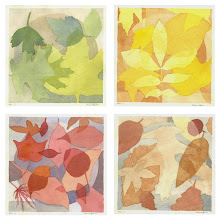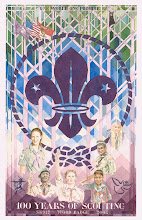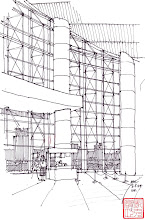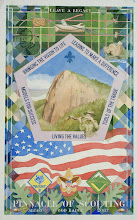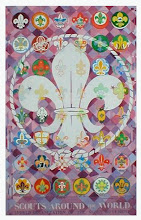There is no point dwelling on Richmond's many missed opportunities. It only makes sense to look at what it is at the moment and paint a vision to what it could become. As an Architect who has spent the past 30 years in design and planning, there is so much opportunity to make this an incredible place. Here are the assets I see:
1. Richmond has an incredible story to tell about the political and social history of our country. Frankly, it is the story of our country. While it has many tragic elements to it, the story is important to tell and is of great interest to most people in the US and many abroad. I find that those who have always lived in Richmond don't have an adequate appreciation for this and therefore don't understand its potential value. Let's put money into those things that will tell the story; it will bring tourism dollars into the area for years to come and perhaps change our own outlook at the same time.
2. The James River flows is an underutilized asset. Having a particular fascination for cities and their interface with rivers, it is obvious to me that the James could be a much bigger part of our urban life. We should do more to utilize this asset - make it cleaner and make it more accessible. These are not opposing goals.
3. VCU is one of the great assets for the city and we should figure out a way to use this resource to make the city stronger. At the moment, VCU is thought of as an island - and often a nuisance to some. An obvious place to start is a cooperative effort with the city's public schools. It is a shame that the city schools send so few graduates to VCU each year. . Let's leverage the various fields of study taught there to engage with the city's youth. Both will benefit from an alliance
4. Architecturally, Richmond has a treasure of old buildings that records our values and behavior in the past. It has many urban neighborhoods that are pedestrian-friendly, safe, and are highly desireable places to live. With that said, we should find a reasonable balance between preservation for preservation sake and un-checked development. Let's identify what has historical or real architectural significance and celebrate it. Let's understand why certain communities work and use that knowledge to make all neighborhoods in the city great places to live.
These four items are tangible, workable concepts. With some vision and community cooperation, Richmond can become a place where people want to come to visit and also a place where they want to come to live.
Saturday, May 30, 2009
Early Lessons on Feedback
As an architecture student at Kentucky 30 years ago, I was expected to spend long hours in my design studio, creating and refining the latest design project. It was common for many of us to spend 40 hours a week in this wonderful, 100 year-old building, right in the middle of campus. Most weeks, I spent more time there than in my dorm.
Each semester, 9 classmates and I would be assigned to a particular studio professor and together would share one of the dozen tall rooms in Pence Hall. Each semester, students were re-shuffled into new groups. As soon as our studio room was assigned, we would rush to stake out our personal space and lay out our low-tech equipment: a door, two sawhorses, and a parallel bar.
Together, we were to share that space for 16 weeks. It was an incredibly creative environment. Most people enjoyed collaboration and willingly offered great feedback. A few however, preferred to work in solitude or at home – offering or receiving little advice from others. Without exception, their work was never given high marks.
Our assigned professor would give each of us a daily critique during the scheduled class-time. The length of this feedback depended on how interested or puzzled they were by our work. It was common for professors to make their rounds at all hours of the night – not only to visit their own class but to check out others’. They would wander into our studio and ask someone to spontaneously explain their work and organizing idea. They were often just curious, but always gave very direct feedback. Feedback usually took the form of conversation wrapped around a sketch or two. Not always.
Paul Amatuzzo was one of these wandering, late-night professors known for his biting critiques. One evening in my second year, he ventured from his own studio across the hall and seemed drawn to the elaborate model I was making. It was becoming quite a thing to behold. Being proud of my effort, I shared my “brilliant” concept and waited for his adoration. Instead, he took two fingers into the heart of my model and pulled out a large chunk. I was horrified. He tossed those dissected parts on the floor and said in his thick New York accent “Now that’s much better, isn’t it Larson? Architecture is about space, not object-making”. He didn’t say anything more, he just left the room.
After the shock wore off, I began to realize what he meant and that his feedback was a wonderful gift. With this one simple lesson, Mr. Ammatuzzo had completely changed my understanding of architecture. He demonstrated with this action, that a building’s interior spaces were at least as important as how it looks on the outside. It’s about how the space works for the people who use it – and it’s not about the sculptural quality (or the architect).
In Architecture school, feedback was part of our ritual. We received it from professors in studio; we gave and received it with classmates at 2 AM pin-ups; we received it at formal juries in front of the entire college to witness. We had to learn humility - not taking feedback personally. Use it to make our efforts better.
Wood Badge teaches about giving and receiving feedback. There are effective ways to give and receive it. As staffers for SR966, we will use feedback to make the course better. Remember some of your own positive experiences with feedback and welcome it as it is intended - a gift.
Each semester, 9 classmates and I would be assigned to a particular studio professor and together would share one of the dozen tall rooms in Pence Hall. Each semester, students were re-shuffled into new groups. As soon as our studio room was assigned, we would rush to stake out our personal space and lay out our low-tech equipment: a door, two sawhorses, and a parallel bar.
Together, we were to share that space for 16 weeks. It was an incredibly creative environment. Most people enjoyed collaboration and willingly offered great feedback. A few however, preferred to work in solitude or at home – offering or receiving little advice from others. Without exception, their work was never given high marks.
Our assigned professor would give each of us a daily critique during the scheduled class-time. The length of this feedback depended on how interested or puzzled they were by our work. It was common for professors to make their rounds at all hours of the night – not only to visit their own class but to check out others’. They would wander into our studio and ask someone to spontaneously explain their work and organizing idea. They were often just curious, but always gave very direct feedback. Feedback usually took the form of conversation wrapped around a sketch or two. Not always.
Paul Amatuzzo was one of these wandering, late-night professors known for his biting critiques. One evening in my second year, he ventured from his own studio across the hall and seemed drawn to the elaborate model I was making. It was becoming quite a thing to behold. Being proud of my effort, I shared my “brilliant” concept and waited for his adoration. Instead, he took two fingers into the heart of my model and pulled out a large chunk. I was horrified. He tossed those dissected parts on the floor and said in his thick New York accent “Now that’s much better, isn’t it Larson? Architecture is about space, not object-making”. He didn’t say anything more, he just left the room.
After the shock wore off, I began to realize what he meant and that his feedback was a wonderful gift. With this one simple lesson, Mr. Ammatuzzo had completely changed my understanding of architecture. He demonstrated with this action, that a building’s interior spaces were at least as important as how it looks on the outside. It’s about how the space works for the people who use it – and it’s not about the sculptural quality (or the architect).
In Architecture school, feedback was part of our ritual. We received it from professors in studio; we gave and received it with classmates at 2 AM pin-ups; we received it at formal juries in front of the entire college to witness. We had to learn humility - not taking feedback personally. Use it to make our efforts better.
Wood Badge teaches about giving and receiving feedback. There are effective ways to give and receive it. As staffers for SR966, we will use feedback to make the course better. Remember some of your own positive experiences with feedback and welcome it as it is intended - a gift.
Teams
How many teams are you involved in at the moment? As a scout leader, you are an important part of at least one great team and many more if you think about it.
The most visible teams are seen in sports, but aren’t families also teams? How about the group of people you work with? One of your teams may be a church choir, a study group, or car-pool.
Teams are created to achieve a purpose. They can perform at a high level or they can fizzle – depending on a lot of factors. Does the team:
- Share a common purpose and passion?
- Have designated leaders and engaged followers?
- Have a plan and structure that everyone understands?
- Have some diversity in the skills and backgrounds of its members?
- Communicate well?
To me, the Wood Badge curriculum boils down to “the team”. Everything the staff will demonstrate and teach for the course’s 6 days revolves around teamwork.
Think about a few of your teams and your role within them. Is your passion strong or are you just fulfilling an obligation? Are you typically chosen to be a leader or do you prefer to let others step up? Would the team be more successful if a new plan or new ideas were put forward? Is everyone on the same page and prepared for an event?
Wood Badge teaches that all new teams go through 4 distinct stages of development (forming, storming, norming, & performing). It is important to recognize these stages as they occur and know that they are part of a normal team-building process.
Over the next 120 days, the SR966 staff will go through this team-building process to become a high-performing team. There are high expectations at the moment and are ready to take on the challenge. There will certainly be some anxiety and maybe even be some “storming” along the way. However, by the time September roles around, I have no doubt that this experienced and spirited staff will come together and deliver an amazing course.
It’s what we have promised and with everyone’s effort is what we will deliver.
The most visible teams are seen in sports, but aren’t families also teams? How about the group of people you work with? One of your teams may be a church choir, a study group, or car-pool.
Teams are created to achieve a purpose. They can perform at a high level or they can fizzle – depending on a lot of factors. Does the team:
- Share a common purpose and passion?
- Have designated leaders and engaged followers?
- Have a plan and structure that everyone understands?
- Have some diversity in the skills and backgrounds of its members?
- Communicate well?
To me, the Wood Badge curriculum boils down to “the team”. Everything the staff will demonstrate and teach for the course’s 6 days revolves around teamwork.
Think about a few of your teams and your role within them. Is your passion strong or are you just fulfilling an obligation? Are you typically chosen to be a leader or do you prefer to let others step up? Would the team be more successful if a new plan or new ideas were put forward? Is everyone on the same page and prepared for an event?
Wood Badge teaches that all new teams go through 4 distinct stages of development (forming, storming, norming, & performing). It is important to recognize these stages as they occur and know that they are part of a normal team-building process.
Over the next 120 days, the SR966 staff will go through this team-building process to become a high-performing team. There are high expectations at the moment and are ready to take on the challenge. There will certainly be some anxiety and maybe even be some “storming” along the way. However, by the time September roles around, I have no doubt that this experienced and spirited staff will come together and deliver an amazing course.
It’s what we have promised and with everyone’s effort is what we will deliver.
Subscribe to:
Posts (Atom)

